Strategic Management Report: M&S Strategy Analysis and Tools
VerifiedAdded on 2023/01/18
|12
|3278
|73
Report
AI Summary
This report provides a comprehensive analysis of strategic management principles, using Marks & Spencer (M&S) as a case study. It begins with an introduction to strategic management, defining its role in evaluating markets and resources to achieve organizational objectives. The main body delves into the processes organizations use to determine their strategy, emphasizing the importance of a clear vision and the steps involved, such as determining strategic position, prioritizing objectives, developing, executing, and reviewing plans. The report then evaluates critical models and tools, including SWOT and PESTEL analyses, to assess the impact of the internal and external environments on business performance. These tools are applied to M&S, examining its strengths, weaknesses, opportunities, and threats, as well as political, economic, social, technological, environmental, and legal factors affecting its operations. Finally, the report critically appraises the importance of change management, considering the complexities, costs, risks, and sustainability of transformation processes within the context of M&S's business operations.

Strategic Management
Paraphrase This Document
Need a fresh take? Get an instant paraphrase of this document with our AI Paraphraser
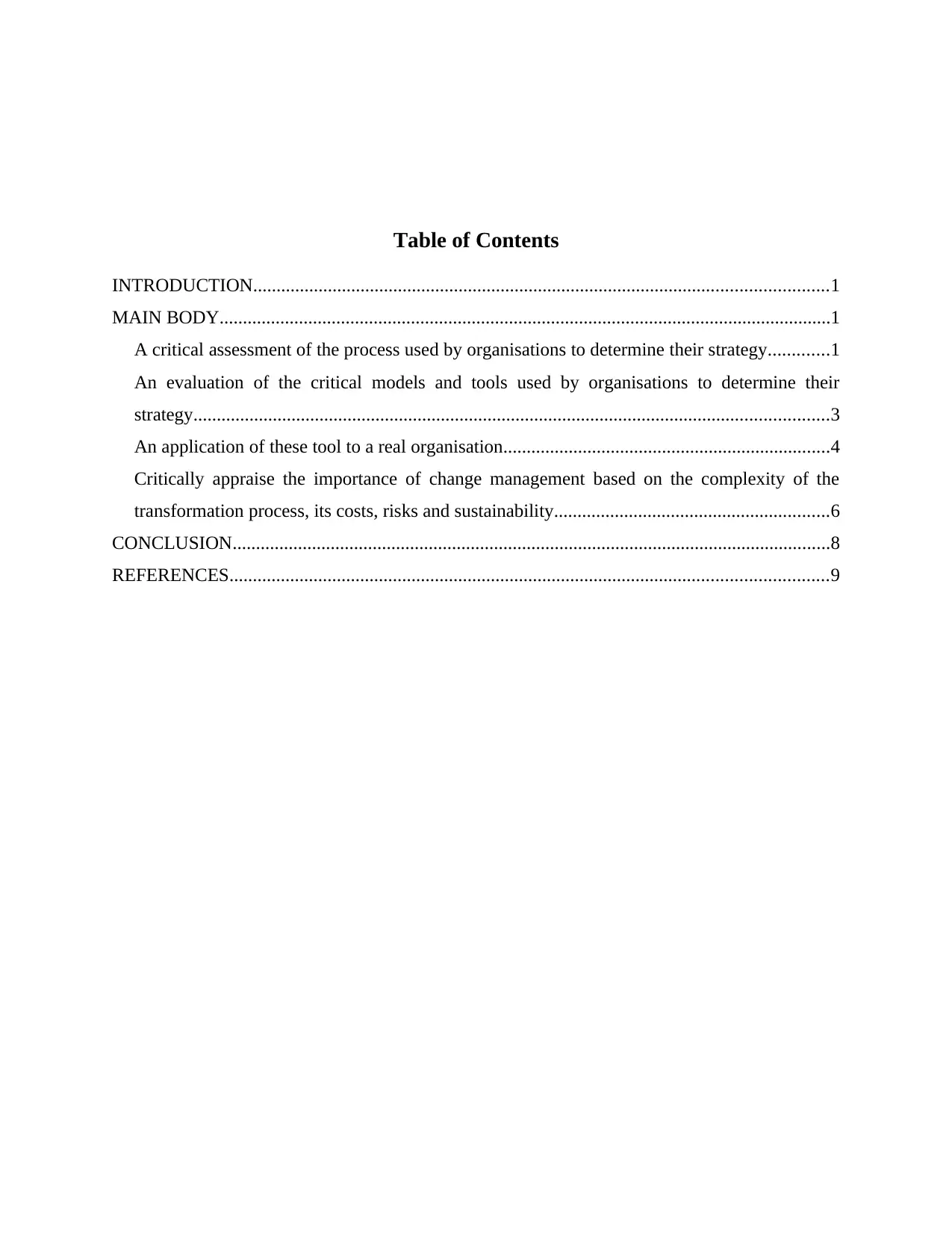
Table of Contents
INTRODUCTION...........................................................................................................................1
MAIN BODY...................................................................................................................................1
A critical assessment of the process used by organisations to determine their strategy.............1
An evaluation of the critical models and tools used by organisations to determine their
strategy........................................................................................................................................3
An application of these tool to a real organisation......................................................................4
Critically appraise the importance of change management based on the complexity of the
transformation process, its costs, risks and sustainability...........................................................6
CONCLUSION................................................................................................................................8
REFERENCES................................................................................................................................9
INTRODUCTION...........................................................................................................................1
MAIN BODY...................................................................................................................................1
A critical assessment of the process used by organisations to determine their strategy.............1
An evaluation of the critical models and tools used by organisations to determine their
strategy........................................................................................................................................3
An application of these tool to a real organisation......................................................................4
Critically appraise the importance of change management based on the complexity of the
transformation process, its costs, risks and sustainability...........................................................6
CONCLUSION................................................................................................................................8
REFERENCES................................................................................................................................9

⊘ This is a preview!⊘
Do you want full access?
Subscribe today to unlock all pages.

Trusted by 1+ million students worldwide

INTRODUCTION
Strategic management refers to the evaluation of market and resources which are required
to carry out by an organisation in order to manage products and services and to develop the plan
for accomplishing the objectives with the help of corrective methods of improvements. Along
with this, strategic management also helps the organisation in increasing the capabilities to deal
with weak areas and implement all the required changes within the existing plan so as to gain
higher competitive advantage. In deeply understanding this concept, the selection organisation is
M&S which is a British multinational retailer and dealing in high quality clothing, food and
home products. This following assignment will cover about the process and different models
which are undertaking by an organisation to determine their strategy. Additionally, it will give its
focus on covering the importance of change management as per the complexities of
transformation process, risk and sustainability (Hitt and Duane Ireland, 2017).
MAIN BODY
A critical assessment of the process used by organisations to determine their strategy
Strategy refers to the long term plan of action which has made to attain a specific
business goals and objectives. Formulation of an effective strategy is the most essential
requirement of the organisation in order to achieve business goal and objectives. This is
considered as a tool which is used by a firm in terms to ascertain the right directions and scope of
the organisation. Other, strategic process define as a method which is used to develop plans to
meet the organisational goals. This process is very wide and useful for M&S as is helps them in
creating a roadmap for which manager of the business requires to put their efforts. It order to
determine their strategy manager of M&S follow some below give steps:
Determine strategic position: This is the first step in which manager of M&S will
prepare themselves for rest of the strategic planning process. In this regard, it is essential for
them to have a clear vision so that they can easily identify the strategic issues, market
opportunities, threats, strengths, weaknesses and other aspects in order to ascertain their
organisation position in the marketplace. Success of this stage depends on abilities and skills of
manager, in case if the manager will not accomplish their role in an effective way then
effectiveness of strategies will affect in a bad manner (Meyer, Neck and Meeks, 2017).
1
Strategic management refers to the evaluation of market and resources which are required
to carry out by an organisation in order to manage products and services and to develop the plan
for accomplishing the objectives with the help of corrective methods of improvements. Along
with this, strategic management also helps the organisation in increasing the capabilities to deal
with weak areas and implement all the required changes within the existing plan so as to gain
higher competitive advantage. In deeply understanding this concept, the selection organisation is
M&S which is a British multinational retailer and dealing in high quality clothing, food and
home products. This following assignment will cover about the process and different models
which are undertaking by an organisation to determine their strategy. Additionally, it will give its
focus on covering the importance of change management as per the complexities of
transformation process, risk and sustainability (Hitt and Duane Ireland, 2017).
MAIN BODY
A critical assessment of the process used by organisations to determine their strategy
Strategy refers to the long term plan of action which has made to attain a specific
business goals and objectives. Formulation of an effective strategy is the most essential
requirement of the organisation in order to achieve business goal and objectives. This is
considered as a tool which is used by a firm in terms to ascertain the right directions and scope of
the organisation. Other, strategic process define as a method which is used to develop plans to
meet the organisational goals. This process is very wide and useful for M&S as is helps them in
creating a roadmap for which manager of the business requires to put their efforts. It order to
determine their strategy manager of M&S follow some below give steps:
Determine strategic position: This is the first step in which manager of M&S will
prepare themselves for rest of the strategic planning process. In this regard, it is essential for
them to have a clear vision so that they can easily identify the strategic issues, market
opportunities, threats, strengths, weaknesses and other aspects in order to ascertain their
organisation position in the marketplace. Success of this stage depends on abilities and skills of
manager, in case if the manager will not accomplish their role in an effective way then
effectiveness of strategies will affect in a bad manner (Meyer, Neck and Meeks, 2017).
1
Paraphrase This Document
Need a fresh take? Get an instant paraphrase of this document with our AI Paraphraser
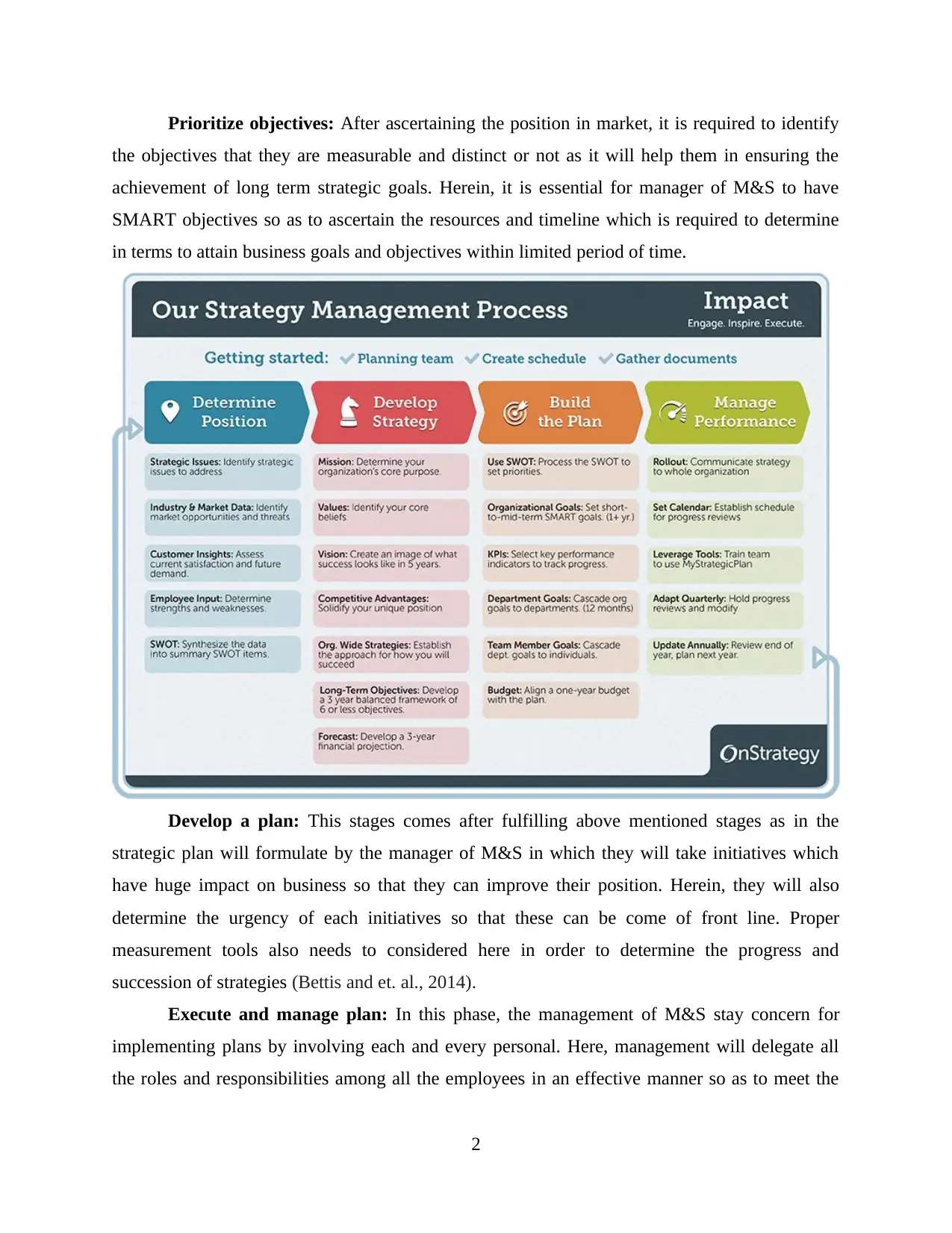
Prioritize objectives: After ascertaining the position in market, it is required to identify
the objectives that they are measurable and distinct or not as it will help them in ensuring the
achievement of long term strategic goals. Herein, it is essential for manager of M&S to have
SMART objectives so as to ascertain the resources and timeline which is required to determine
in terms to attain business goals and objectives within limited period of time.
Develop a plan: This stages comes after fulfilling above mentioned stages as in the
strategic plan will formulate by the manager of M&S in which they will take initiatives which
have huge impact on business so that they can improve their position. Herein, they will also
determine the urgency of each initiatives so that these can be come of front line. Proper
measurement tools also needs to considered here in order to determine the progress and
succession of strategies (Bettis and et. al., 2014).
Execute and manage plan: In this phase, the management of M&S stay concern for
implementing plans by involving each and every personal. Here, management will delegate all
the roles and responsibilities among all the employees in an effective manner so as to meet the
2
the objectives that they are measurable and distinct or not as it will help them in ensuring the
achievement of long term strategic goals. Herein, it is essential for manager of M&S to have
SMART objectives so as to ascertain the resources and timeline which is required to determine
in terms to attain business goals and objectives within limited period of time.
Develop a plan: This stages comes after fulfilling above mentioned stages as in the
strategic plan will formulate by the manager of M&S in which they will take initiatives which
have huge impact on business so that they can improve their position. Herein, they will also
determine the urgency of each initiatives so that these can be come of front line. Proper
measurement tools also needs to considered here in order to determine the progress and
succession of strategies (Bettis and et. al., 2014).
Execute and manage plan: In this phase, the management of M&S stay concern for
implementing plans by involving each and every personal. Here, management will delegate all
the roles and responsibilities among all the employees in an effective manner so as to meet the
2
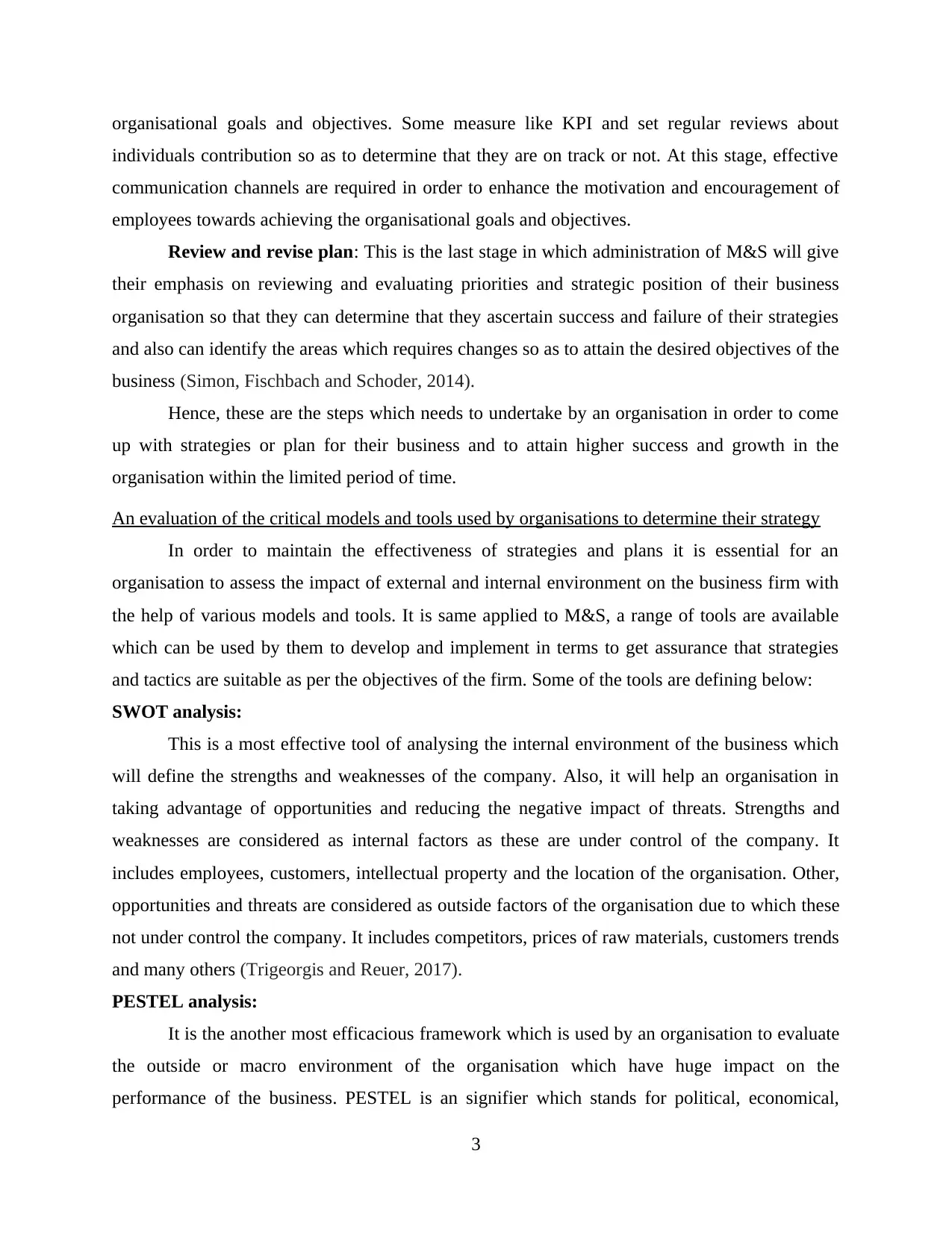
organisational goals and objectives. Some measure like KPI and set regular reviews about
individuals contribution so as to determine that they are on track or not. At this stage, effective
communication channels are required in order to enhance the motivation and encouragement of
employees towards achieving the organisational goals and objectives.
Review and revise plan: This is the last stage in which administration of M&S will give
their emphasis on reviewing and evaluating priorities and strategic position of their business
organisation so that they can determine that they ascertain success and failure of their strategies
and also can identify the areas which requires changes so as to attain the desired objectives of the
business (Simon, Fischbach and Schoder, 2014).
Hence, these are the steps which needs to undertake by an organisation in order to come
up with strategies or plan for their business and to attain higher success and growth in the
organisation within the limited period of time.
An evaluation of the critical models and tools used by organisations to determine their strategy
In order to maintain the effectiveness of strategies and plans it is essential for an
organisation to assess the impact of external and internal environment on the business firm with
the help of various models and tools. It is same applied to M&S, a range of tools are available
which can be used by them to develop and implement in terms to get assurance that strategies
and tactics are suitable as per the objectives of the firm. Some of the tools are defining below:
SWOT analysis:
This is a most effective tool of analysing the internal environment of the business which
will define the strengths and weaknesses of the company. Also, it will help an organisation in
taking advantage of opportunities and reducing the negative impact of threats. Strengths and
weaknesses are considered as internal factors as these are under control of the company. It
includes employees, customers, intellectual property and the location of the organisation. Other,
opportunities and threats are considered as outside factors of the organisation due to which these
not under control the company. It includes competitors, prices of raw materials, customers trends
and many others (Trigeorgis and Reuer, 2017).
PESTEL analysis:
It is the another most efficacious framework which is used by an organisation to evaluate
the outside or macro environment of the organisation which have huge impact on the
performance of the business. PESTEL is an signifier which stands for political, economical,
3
individuals contribution so as to determine that they are on track or not. At this stage, effective
communication channels are required in order to enhance the motivation and encouragement of
employees towards achieving the organisational goals and objectives.
Review and revise plan: This is the last stage in which administration of M&S will give
their emphasis on reviewing and evaluating priorities and strategic position of their business
organisation so that they can determine that they ascertain success and failure of their strategies
and also can identify the areas which requires changes so as to attain the desired objectives of the
business (Simon, Fischbach and Schoder, 2014).
Hence, these are the steps which needs to undertake by an organisation in order to come
up with strategies or plan for their business and to attain higher success and growth in the
organisation within the limited period of time.
An evaluation of the critical models and tools used by organisations to determine their strategy
In order to maintain the effectiveness of strategies and plans it is essential for an
organisation to assess the impact of external and internal environment on the business firm with
the help of various models and tools. It is same applied to M&S, a range of tools are available
which can be used by them to develop and implement in terms to get assurance that strategies
and tactics are suitable as per the objectives of the firm. Some of the tools are defining below:
SWOT analysis:
This is a most effective tool of analysing the internal environment of the business which
will define the strengths and weaknesses of the company. Also, it will help an organisation in
taking advantage of opportunities and reducing the negative impact of threats. Strengths and
weaknesses are considered as internal factors as these are under control of the company. It
includes employees, customers, intellectual property and the location of the organisation. Other,
opportunities and threats are considered as outside factors of the organisation due to which these
not under control the company. It includes competitors, prices of raw materials, customers trends
and many others (Trigeorgis and Reuer, 2017).
PESTEL analysis:
It is the another most efficacious framework which is used by an organisation to evaluate
the outside or macro environment of the organisation which have huge impact on the
performance of the business. PESTEL is an signifier which stands for political, economical,
3
⊘ This is a preview!⊘
Do you want full access?
Subscribe today to unlock all pages.

Trusted by 1+ million students worldwide

social, technological, environmental and legal. It is essential for an organisation to undertake this
framework within their operations so as to come up with effective strategies and plans for their
business after situational analysis. Organisations who are able to successfully monitor and react
to changes towards the external environment can differentiate themselves from the competitors
and can stay ahead from them.
An application of these tool to a real organisation
These above mentioned tools are very helpful and beneficial for any kind of organisation
as these helps them in operating all their activities without any crisis. With the help of these tools
like SWOT and PESTEL, manager of M&S also will be able to evaluate the marketing
environment of their business which enables them to carry out all their activities in a significant
ways so as to stay ahead from competitors (Certo and et. al., 2016). The application of both these
tools are defining below:
SWOT analysis of M&S:
As per the above discussion, it can be stated that this is the most significant tool for an
organisation. As M&S is operating their business activities in retailing sector due to which it is
essential for them to analyse their external environment in terms to conduct all their activities
smoothly. In this regard, they can use SWOT analysis as this will help them in ascertaining the
strengths and weaknesses of their organisation. Also, it will enables them to identify available
opportunities in the marketplace and threats which can hindrance their performance. SWOT
analysis of M&S is given below:
Strengthens Weaknesses
The major strength of M&S is that it is
a higher recognised brand due to
offering a wide variety of products to
its customers.
Another, it has huge presence in across
the world as it has almost 900 stores
across the world.
This is considered as a non-trendy store
by various customers as they have
made wrong assumptions that it is only
manufacturing women' s and men's
clothes not for the teenager and young
people.
Other it has poor scalability of supply
chain due to which customers are not
able to get products at time.
4
framework within their operations so as to come up with effective strategies and plans for their
business after situational analysis. Organisations who are able to successfully monitor and react
to changes towards the external environment can differentiate themselves from the competitors
and can stay ahead from them.
An application of these tool to a real organisation
These above mentioned tools are very helpful and beneficial for any kind of organisation
as these helps them in operating all their activities without any crisis. With the help of these tools
like SWOT and PESTEL, manager of M&S also will be able to evaluate the marketing
environment of their business which enables them to carry out all their activities in a significant
ways so as to stay ahead from competitors (Certo and et. al., 2016). The application of both these
tools are defining below:
SWOT analysis of M&S:
As per the above discussion, it can be stated that this is the most significant tool for an
organisation. As M&S is operating their business activities in retailing sector due to which it is
essential for them to analyse their external environment in terms to conduct all their activities
smoothly. In this regard, they can use SWOT analysis as this will help them in ascertaining the
strengths and weaknesses of their organisation. Also, it will enables them to identify available
opportunities in the marketplace and threats which can hindrance their performance. SWOT
analysis of M&S is given below:
Strengthens Weaknesses
The major strength of M&S is that it is
a higher recognised brand due to
offering a wide variety of products to
its customers.
Another, it has huge presence in across
the world as it has almost 900 stores
across the world.
This is considered as a non-trendy store
by various customers as they have
made wrong assumptions that it is only
manufacturing women' s and men's
clothes not for the teenager and young
people.
Other it has poor scalability of supply
chain due to which customers are not
able to get products at time.
4
Paraphrase This Document
Need a fresh take? Get an instant paraphrase of this document with our AI Paraphraser

Opportunities Threats
By enhancing online presence they can
bolster their market position.
Expanding business in Asia will
enables them to attain higher
profitability as there is huge demand of
ethnic wear.
The biggest threat of M&S is
competition as they have to face cut-
throat competition in the marketplace
from Zara, Gap, Uniqlo etc.
Changing trends within the clothing
space is also a big challenge for them
as it might can increase overall cost of
the business.
PESTEL analysis of M&S:
As M&S is operating their business activities worldwide due to which it become more
essential for them to assess the external environment of the business so that they can reduce the
negative impact from the organisational performance. In this regard they can use PESTEL
analysis which is defining in detail below:
Political factors: These are those factors which run and change by the government
bodies. It includes tax policy, labour law, foreign market, environmental law and many others.
Consideration of these factors by manager of M&S in their operations is essential as these have
huge impact on the performance of the business. For example, if government will allow free
trade in the country then M&S will be able to import foreign products with the motive of sale at
cheaper price so as to maintain healthy profit margin (Karadag, 2015).
Economical factors: It incurs due to the economical changes of country which straight
affect the long term benefit of company. These factors comprises inflation, interest rate,
exchange rate etc. which has huge impact on organisational performance. For example, M&S is
greatly affected by competitors discounted price as M&S is dealing in premium price because of
their higher quality. This might results competitors are able to stealing higher market share from
M&S.
Social factors: These are the areas which refers to attitude and shared beliefs of
population. It includes age distribution, careers attitudes, population growth etc. These factors
define that M&S needs to consider current market segments and customers perceptions in order
to attain higher customers satisfaction. For instance, M&S needs to give its focus on
5
By enhancing online presence they can
bolster their market position.
Expanding business in Asia will
enables them to attain higher
profitability as there is huge demand of
ethnic wear.
The biggest threat of M&S is
competition as they have to face cut-
throat competition in the marketplace
from Zara, Gap, Uniqlo etc.
Changing trends within the clothing
space is also a big challenge for them
as it might can increase overall cost of
the business.
PESTEL analysis of M&S:
As M&S is operating their business activities worldwide due to which it become more
essential for them to assess the external environment of the business so that they can reduce the
negative impact from the organisational performance. In this regard they can use PESTEL
analysis which is defining in detail below:
Political factors: These are those factors which run and change by the government
bodies. It includes tax policy, labour law, foreign market, environmental law and many others.
Consideration of these factors by manager of M&S in their operations is essential as these have
huge impact on the performance of the business. For example, if government will allow free
trade in the country then M&S will be able to import foreign products with the motive of sale at
cheaper price so as to maintain healthy profit margin (Karadag, 2015).
Economical factors: It incurs due to the economical changes of country which straight
affect the long term benefit of company. These factors comprises inflation, interest rate,
exchange rate etc. which has huge impact on organisational performance. For example, M&S is
greatly affected by competitors discounted price as M&S is dealing in premium price because of
their higher quality. This might results competitors are able to stealing higher market share from
M&S.
Social factors: These are the areas which refers to attitude and shared beliefs of
population. It includes age distribution, careers attitudes, population growth etc. These factors
define that M&S needs to consider current market segments and customers perceptions in order
to attain higher customers satisfaction. For instance, M&S needs to give its focus on
5
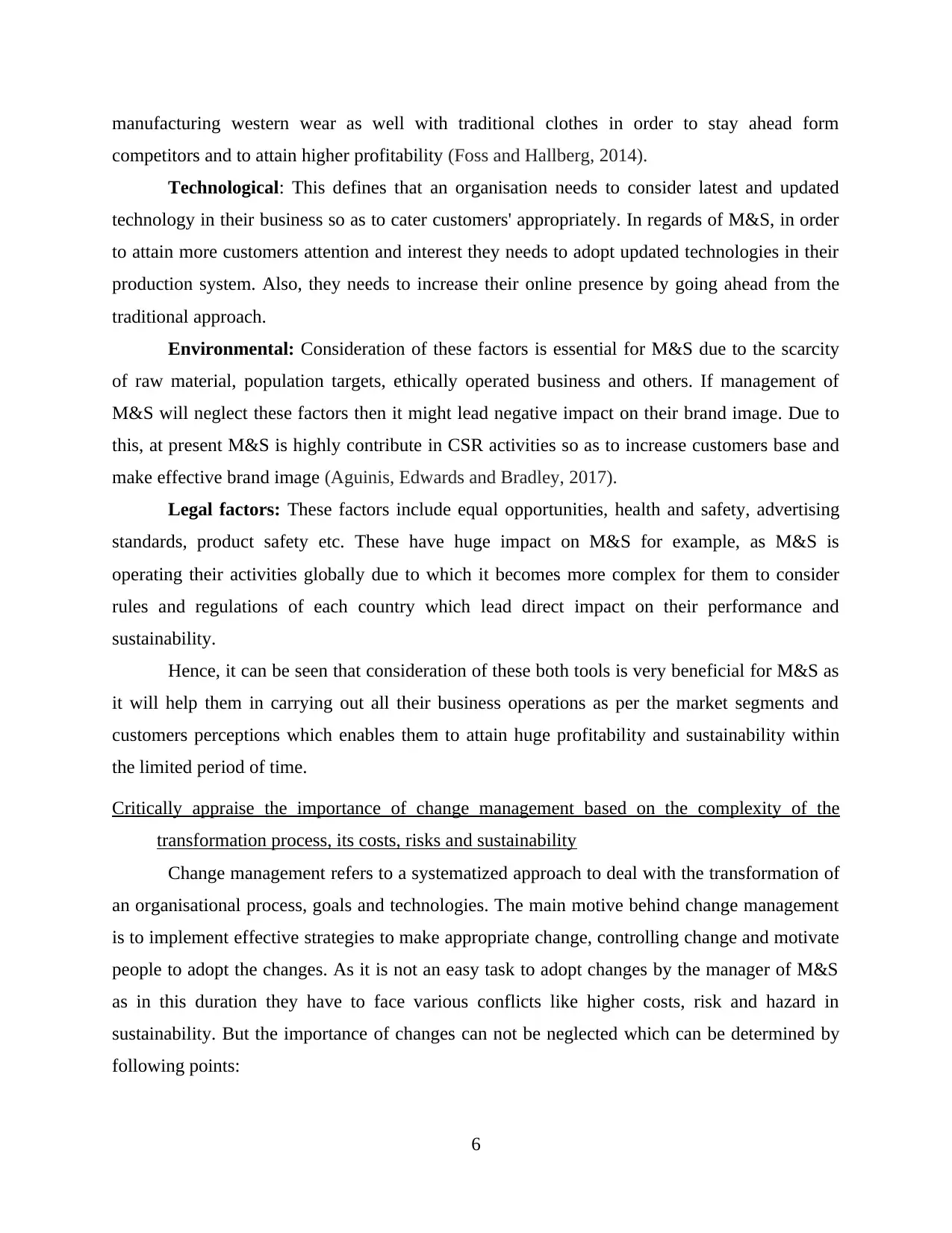
manufacturing western wear as well with traditional clothes in order to stay ahead form
competitors and to attain higher profitability (Foss and Hallberg, 2014).
Technological: This defines that an organisation needs to consider latest and updated
technology in their business so as to cater customers' appropriately. In regards of M&S, in order
to attain more customers attention and interest they needs to adopt updated technologies in their
production system. Also, they needs to increase their online presence by going ahead from the
traditional approach.
Environmental: Consideration of these factors is essential for M&S due to the scarcity
of raw material, population targets, ethically operated business and others. If management of
M&S will neglect these factors then it might lead negative impact on their brand image. Due to
this, at present M&S is highly contribute in CSR activities so as to increase customers base and
make effective brand image (Aguinis, Edwards and Bradley, 2017).
Legal factors: These factors include equal opportunities, health and safety, advertising
standards, product safety etc. These have huge impact on M&S for example, as M&S is
operating their activities globally due to which it becomes more complex for them to consider
rules and regulations of each country which lead direct impact on their performance and
sustainability.
Hence, it can be seen that consideration of these both tools is very beneficial for M&S as
it will help them in carrying out all their business operations as per the market segments and
customers perceptions which enables them to attain huge profitability and sustainability within
the limited period of time.
Critically appraise the importance of change management based on the complexity of the
transformation process, its costs, risks and sustainability
Change management refers to a systematized approach to deal with the transformation of
an organisational process, goals and technologies. The main motive behind change management
is to implement effective strategies to make appropriate change, controlling change and motivate
people to adopt the changes. As it is not an easy task to adopt changes by the manager of M&S
as in this duration they have to face various conflicts like higher costs, risk and hazard in
sustainability. But the importance of changes can not be neglected which can be determined by
following points:
6
competitors and to attain higher profitability (Foss and Hallberg, 2014).
Technological: This defines that an organisation needs to consider latest and updated
technology in their business so as to cater customers' appropriately. In regards of M&S, in order
to attain more customers attention and interest they needs to adopt updated technologies in their
production system. Also, they needs to increase their online presence by going ahead from the
traditional approach.
Environmental: Consideration of these factors is essential for M&S due to the scarcity
of raw material, population targets, ethically operated business and others. If management of
M&S will neglect these factors then it might lead negative impact on their brand image. Due to
this, at present M&S is highly contribute in CSR activities so as to increase customers base and
make effective brand image (Aguinis, Edwards and Bradley, 2017).
Legal factors: These factors include equal opportunities, health and safety, advertising
standards, product safety etc. These have huge impact on M&S for example, as M&S is
operating their activities globally due to which it becomes more complex for them to consider
rules and regulations of each country which lead direct impact on their performance and
sustainability.
Hence, it can be seen that consideration of these both tools is very beneficial for M&S as
it will help them in carrying out all their business operations as per the market segments and
customers perceptions which enables them to attain huge profitability and sustainability within
the limited period of time.
Critically appraise the importance of change management based on the complexity of the
transformation process, its costs, risks and sustainability
Change management refers to a systematized approach to deal with the transformation of
an organisational process, goals and technologies. The main motive behind change management
is to implement effective strategies to make appropriate change, controlling change and motivate
people to adopt the changes. As it is not an easy task to adopt changes by the manager of M&S
as in this duration they have to face various conflicts like higher costs, risk and hazard in
sustainability. But the importance of changes can not be neglected which can be determined by
following points:
6
⊘ This is a preview!⊘
Do you want full access?
Subscribe today to unlock all pages.

Trusted by 1+ million students worldwide
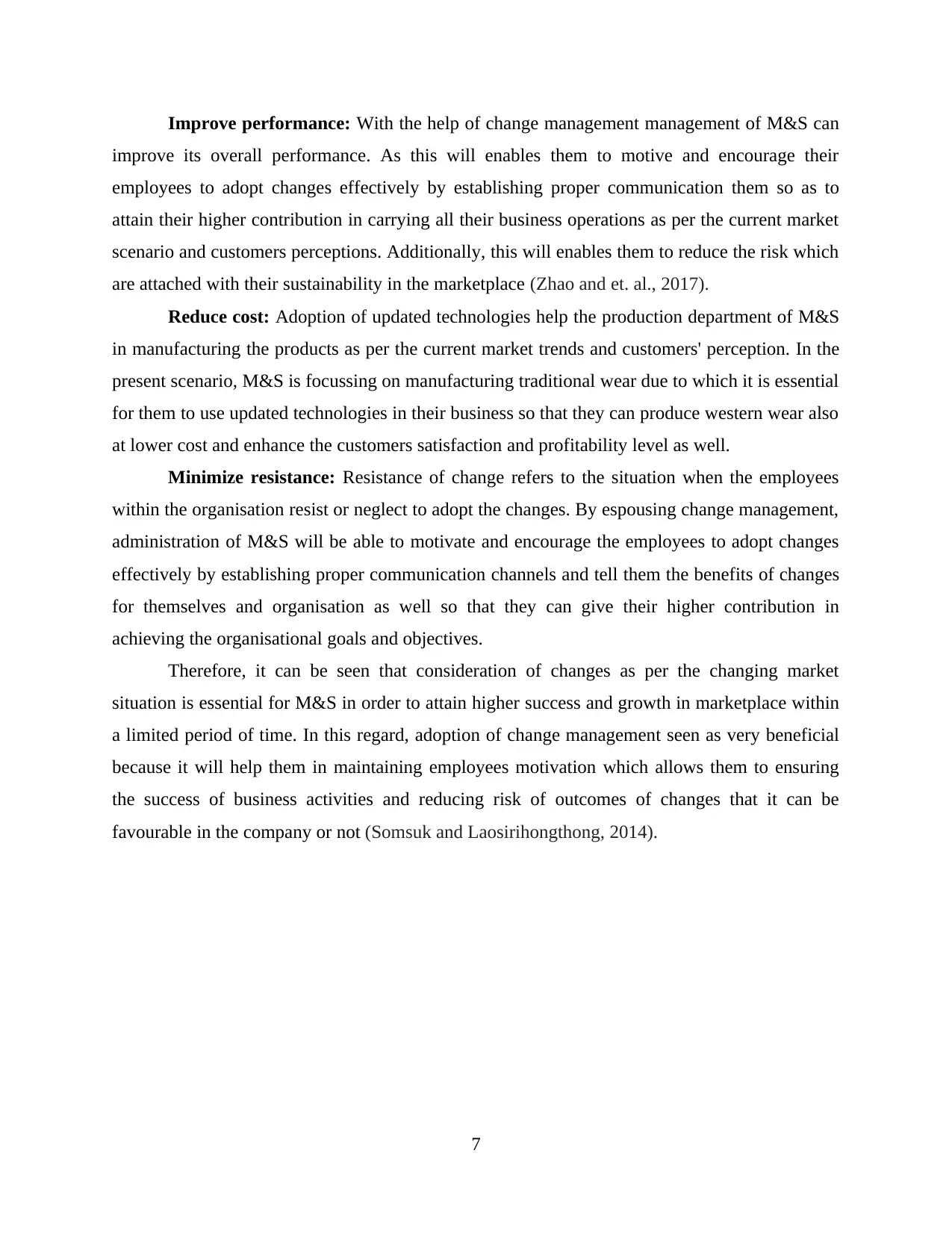
Improve performance: With the help of change management management of M&S can
improve its overall performance. As this will enables them to motive and encourage their
employees to adopt changes effectively by establishing proper communication them so as to
attain their higher contribution in carrying all their business operations as per the current market
scenario and customers perceptions. Additionally, this will enables them to reduce the risk which
are attached with their sustainability in the marketplace (Zhao and et. al., 2017).
Reduce cost: Adoption of updated technologies help the production department of M&S
in manufacturing the products as per the current market trends and customers' perception. In the
present scenario, M&S is focussing on manufacturing traditional wear due to which it is essential
for them to use updated technologies in their business so that they can produce western wear also
at lower cost and enhance the customers satisfaction and profitability level as well.
Minimize resistance: Resistance of change refers to the situation when the employees
within the organisation resist or neglect to adopt the changes. By espousing change management,
administration of M&S will be able to motivate and encourage the employees to adopt changes
effectively by establishing proper communication channels and tell them the benefits of changes
for themselves and organisation as well so that they can give their higher contribution in
achieving the organisational goals and objectives.
Therefore, it can be seen that consideration of changes as per the changing market
situation is essential for M&S in order to attain higher success and growth in marketplace within
a limited period of time. In this regard, adoption of change management seen as very beneficial
because it will help them in maintaining employees motivation which allows them to ensuring
the success of business activities and reducing risk of outcomes of changes that it can be
favourable in the company or not (Somsuk and Laosirihongthong, 2014).
7
improve its overall performance. As this will enables them to motive and encourage their
employees to adopt changes effectively by establishing proper communication them so as to
attain their higher contribution in carrying all their business operations as per the current market
scenario and customers perceptions. Additionally, this will enables them to reduce the risk which
are attached with their sustainability in the marketplace (Zhao and et. al., 2017).
Reduce cost: Adoption of updated technologies help the production department of M&S
in manufacturing the products as per the current market trends and customers' perception. In the
present scenario, M&S is focussing on manufacturing traditional wear due to which it is essential
for them to use updated technologies in their business so that they can produce western wear also
at lower cost and enhance the customers satisfaction and profitability level as well.
Minimize resistance: Resistance of change refers to the situation when the employees
within the organisation resist or neglect to adopt the changes. By espousing change management,
administration of M&S will be able to motivate and encourage the employees to adopt changes
effectively by establishing proper communication channels and tell them the benefits of changes
for themselves and organisation as well so that they can give their higher contribution in
achieving the organisational goals and objectives.
Therefore, it can be seen that consideration of changes as per the changing market
situation is essential for M&S in order to attain higher success and growth in marketplace within
a limited period of time. In this regard, adoption of change management seen as very beneficial
because it will help them in maintaining employees motivation which allows them to ensuring
the success of business activities and reducing risk of outcomes of changes that it can be
favourable in the company or not (Somsuk and Laosirihongthong, 2014).
7
Paraphrase This Document
Need a fresh take? Get an instant paraphrase of this document with our AI Paraphraser
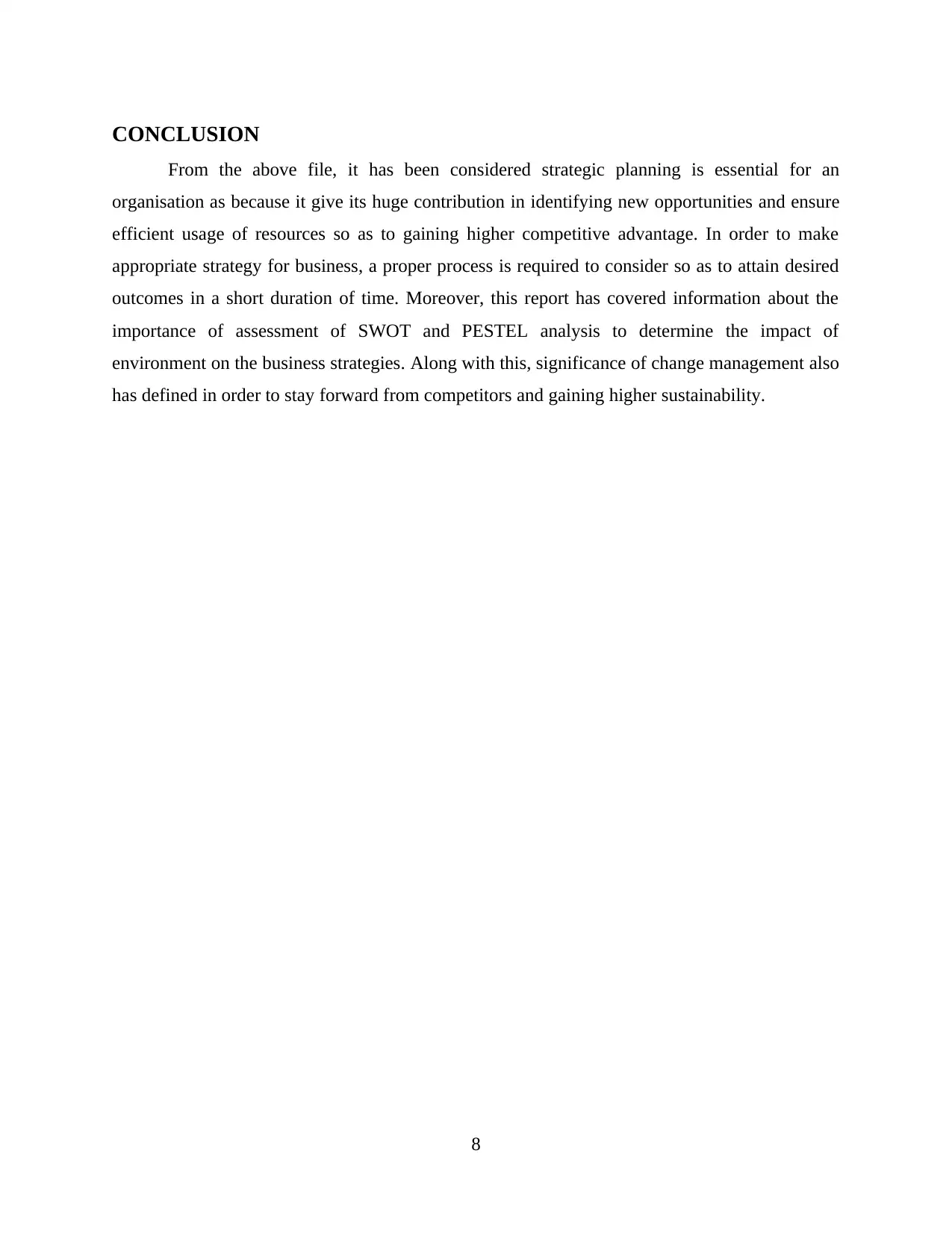
CONCLUSION
From the above file, it has been considered strategic planning is essential for an
organisation as because it give its huge contribution in identifying new opportunities and ensure
efficient usage of resources so as to gaining higher competitive advantage. In order to make
appropriate strategy for business, a proper process is required to consider so as to attain desired
outcomes in a short duration of time. Moreover, this report has covered information about the
importance of assessment of SWOT and PESTEL analysis to determine the impact of
environment on the business strategies. Along with this, significance of change management also
has defined in order to stay forward from competitors and gaining higher sustainability.
8
From the above file, it has been considered strategic planning is essential for an
organisation as because it give its huge contribution in identifying new opportunities and ensure
efficient usage of resources so as to gaining higher competitive advantage. In order to make
appropriate strategy for business, a proper process is required to consider so as to attain desired
outcomes in a short duration of time. Moreover, this report has covered information about the
importance of assessment of SWOT and PESTEL analysis to determine the impact of
environment on the business strategies. Along with this, significance of change management also
has defined in order to stay forward from competitors and gaining higher sustainability.
8
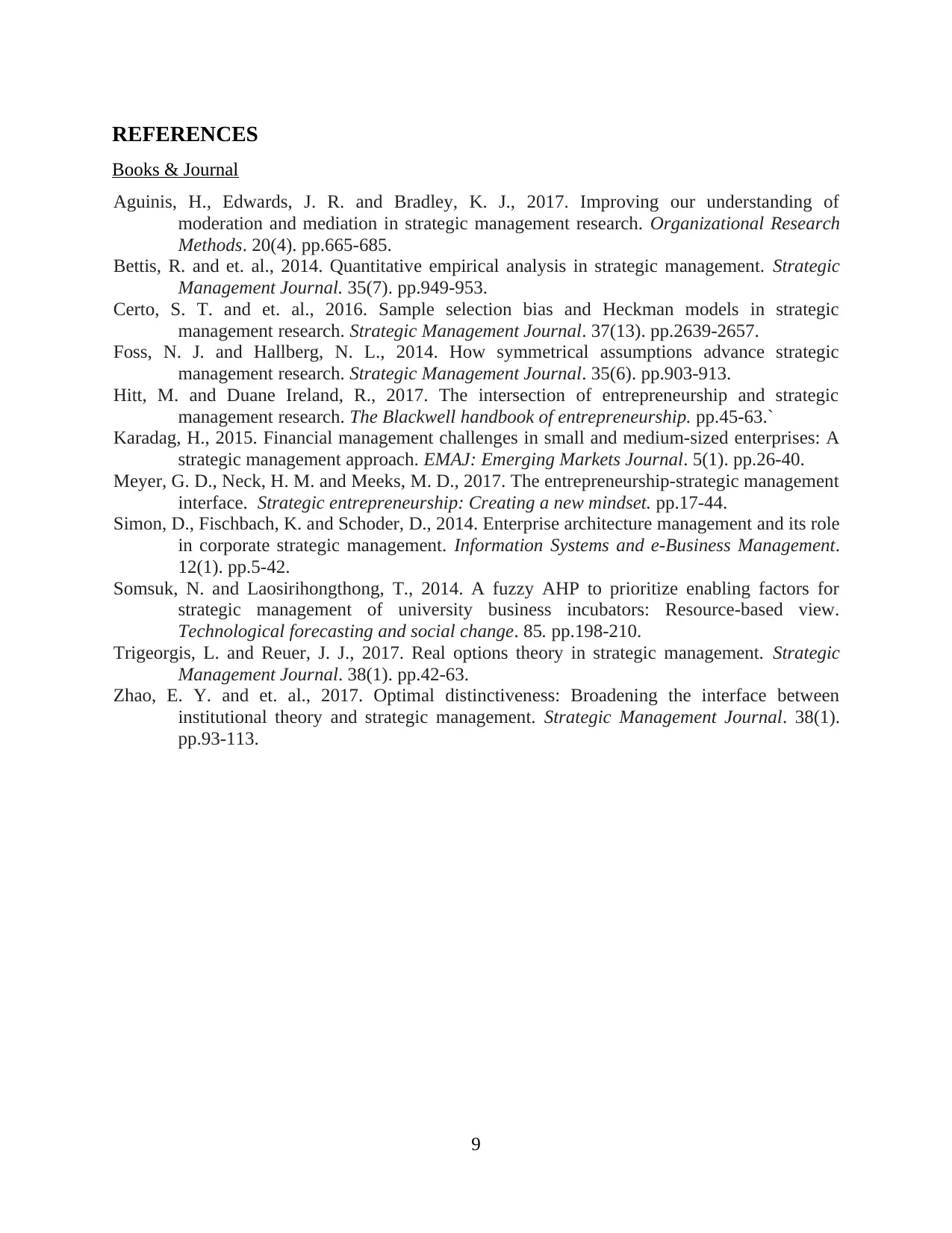
REFERENCES
Books & Journal
Aguinis, H., Edwards, J. R. and Bradley, K. J., 2017. Improving our understanding of
moderation and mediation in strategic management research. Organizational Research
Methods. 20(4). pp.665-685.
Bettis, R. and et. al., 2014. Quantitative empirical analysis in strategic management. Strategic
Management Journal. 35(7). pp.949-953.
Certo, S. T. and et. al., 2016. Sample selection bias and Heckman models in strategic
management research. Strategic Management Journal. 37(13). pp.2639-2657.
Foss, N. J. and Hallberg, N. L., 2014. How symmetrical assumptions advance strategic
management research. Strategic Management Journal. 35(6). pp.903-913.
Hitt, M. and Duane Ireland, R., 2017. The intersection of entrepreneurship and strategic
management research. The Blackwell handbook of entrepreneurship. pp.45-63.`
Karadag, H., 2015. Financial management challenges in small and medium-sized enterprises: A
strategic management approach. EMAJ: Emerging Markets Journal. 5(1). pp.26-40.
Meyer, G. D., Neck, H. M. and Meeks, M. D., 2017. The entrepreneurship‐strategic management
interface. Strategic entrepreneurship: Creating a new mindset. pp.17-44.
Simon, D., Fischbach, K. and Schoder, D., 2014. Enterprise architecture management and its role
in corporate strategic management. Information Systems and e-Business Management.
12(1). pp.5-42.
Somsuk, N. and Laosirihongthong, T., 2014. A fuzzy AHP to prioritize enabling factors for
strategic management of university business incubators: Resource-based view.
Technological forecasting and social change. 85. pp.198-210.
Trigeorgis, L. and Reuer, J. J., 2017. Real options theory in strategic management. Strategic
Management Journal. 38(1). pp.42-63.
Zhao, E. Y. and et. al., 2017. Optimal distinctiveness: Broadening the interface between
institutional theory and strategic management. Strategic Management Journal. 38(1).
pp.93-113.
9
Books & Journal
Aguinis, H., Edwards, J. R. and Bradley, K. J., 2017. Improving our understanding of
moderation and mediation in strategic management research. Organizational Research
Methods. 20(4). pp.665-685.
Bettis, R. and et. al., 2014. Quantitative empirical analysis in strategic management. Strategic
Management Journal. 35(7). pp.949-953.
Certo, S. T. and et. al., 2016. Sample selection bias and Heckman models in strategic
management research. Strategic Management Journal. 37(13). pp.2639-2657.
Foss, N. J. and Hallberg, N. L., 2014. How symmetrical assumptions advance strategic
management research. Strategic Management Journal. 35(6). pp.903-913.
Hitt, M. and Duane Ireland, R., 2017. The intersection of entrepreneurship and strategic
management research. The Blackwell handbook of entrepreneurship. pp.45-63.`
Karadag, H., 2015. Financial management challenges in small and medium-sized enterprises: A
strategic management approach. EMAJ: Emerging Markets Journal. 5(1). pp.26-40.
Meyer, G. D., Neck, H. M. and Meeks, M. D., 2017. The entrepreneurship‐strategic management
interface. Strategic entrepreneurship: Creating a new mindset. pp.17-44.
Simon, D., Fischbach, K. and Schoder, D., 2014. Enterprise architecture management and its role
in corporate strategic management. Information Systems and e-Business Management.
12(1). pp.5-42.
Somsuk, N. and Laosirihongthong, T., 2014. A fuzzy AHP to prioritize enabling factors for
strategic management of university business incubators: Resource-based view.
Technological forecasting and social change. 85. pp.198-210.
Trigeorgis, L. and Reuer, J. J., 2017. Real options theory in strategic management. Strategic
Management Journal. 38(1). pp.42-63.
Zhao, E. Y. and et. al., 2017. Optimal distinctiveness: Broadening the interface between
institutional theory and strategic management. Strategic Management Journal. 38(1).
pp.93-113.
9
⊘ This is a preview!⊘
Do you want full access?
Subscribe today to unlock all pages.

Trusted by 1+ million students worldwide
1 out of 12
Related Documents
Your All-in-One AI-Powered Toolkit for Academic Success.
+13062052269
info@desklib.com
Available 24*7 on WhatsApp / Email
![[object Object]](/_next/static/media/star-bottom.7253800d.svg)
Unlock your academic potential
Copyright © 2020–2025 A2Z Services. All Rights Reserved. Developed and managed by ZUCOL.




